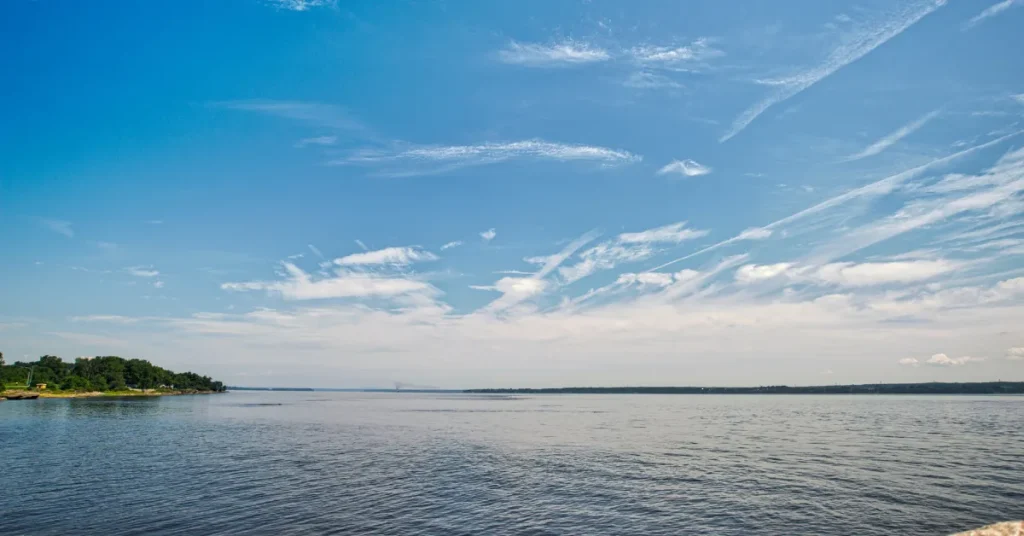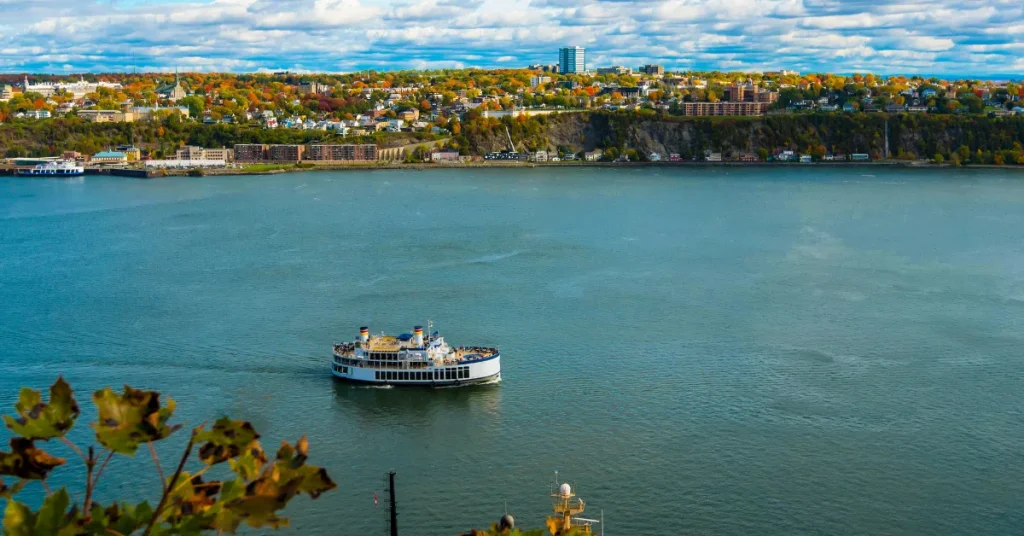The St. Lawrence River reaches depths of over 250 feet. Its deepest point is in the Laurentian Trough.
Exploring the majestic St. Lawrence River reveals its crucial role as both a natural habitat and a key shipping route. Spanning a vast area from the Great Lakes to the Atlantic Ocean, this river serves as the gateway to North America’s inland industries.
With a diverse ecosystem, the river hosts a variety of fish species and plays a significant part in commercial fishing. Travelers and locals alike cherish the river’s picturesque landscapes, making it a destination for recreational activities like boating and fishing.
As an important waterway for trade, its depth accommodates large vessels, crucial for economic exchange between Canada and the United States.
The St. Lawrence River’s blend of ecological significance and economic utility underscores its importance in North American geography.

Exploring The Depths Of The St. Lawrence River
The St. Lawrence River, a vital waterway, is both majestic and mysterious. It serves as a crucial link between the Great Lakes and the Atlantic Ocean.
Its depth varies widely, presenting a fascinating topic for explorers and scientists alike. Let’s dive into understanding just how deep this iconic river runs.
Geographic Scope And Importance
The St. Lawrence is not just a river; it’s an ecosystem that supports many lives. It stretches from Lake Ontario to the Atlantic, crossing international borders. This river is an economic powerhouse, supporting trade and travel.
Varied Depths Along The River’s Course
As the river snakes its way through North America, depths can surprise you. Near the shore, the river can be quite shallow, perfect for wading birds.
In contrast, the river’s midsections plunge into deep channels, some over 200 feet deep. These areas are home to shipwrecks and diverse aquatic life.
| Location | Average Depth (feet) | Maximum Depth (feet) |
| Lake Ontario outlet | 10 | 245 |
| Thousand Islands | 25 | 250 |
| Montreal to Quebec City | 40 | 200 |
| Below Quebec City | 65 | Over 400 |
- Shallow zones serve as habitats for wildlife.
- Deeper channels accommodate large vessels.
- Depth affects water flow and fish migration.
- It shapes river navigation and safety.
Measuring The Deep: Techniques And Tools
Exploring the depth of the St. Lawrence River calls for precision and technology. From ancient rope lines to cutting-edge gadgets, each era employs distinct methods. This dive into depth measurement reveals the river’s secrets beneath the surface.
Historical Methods Of Depth Measurement
The quest to grasp river depths began with basic tools. Mariners relied on simple yet effective techniques to chart the murky deep.
- Lead lines: Hefty weights attached to ropes gauged depth by sinking to the riverbed.
- Marked ropes: Knots or marks at intervals allowed for quick estimations.
Modern Sonar And Satellite Technology
Advancements in technology brought dramatic changes. Today’s explorers wield sonar and satellites for a glimpse below.
Sonar: Sound waves map the river floor with remarkable accuracy. They show depth changes and hidden formations.
Satellite imagery: From space, satellites assist in measuring depths indirectly. They detect surface changes hinting at underwater landscapes.
| Tool | Use |
| Lead Lines | Estimate river depth by physical touch |
| Sonar Equipment | Provide accurate depth using sound waves |
| Satellites | Measure depth by sensing surface changes |
The River’s Deepest Points

The St. Lawrence River stands as a testament to nature’s marvel, carving a path through Canada and the United States.
Yet beneath its swift currents and sprawling expanse lies a world less spoken of. The depths of this river hold secrets to its historical significance as a trade route and ecosystem.
The Laurentian Channel’s Significance
The Laurentian Channel is more than just a section of the river. It is the river’s artery, guiding marine life and shipping routes.
This underwater valley shapes the river’s behavior and its interaction with surrounding habitats. As a key feature of the river, the channel serves multiple purposes:
- A vital pathway for migrating species.
- A navigational route for ships entering the Great Lakes.
- An influential factor in the river’s aquatic life distribution.
Recorded Maximum Depths
The St. Lawrence River’s depths vary, reflecting its dynamic nature and complex geology. Explorers and researchers have long sought to measure these depths:
| Location | Depth |
| Quebec City | 19.5 meters |
| Montreal | 6 meters |
| The Laurentian Channel | Over 250 meters |
The Laurentian Channel boasts the most impressive depth, rivaling that of other renowned underwater landscapes. It creates an ecosystem that is both unique and essential to the river’s identity.
The channel’s deepest point links to the ocean floor, allowing ocean-going vessels to sail into the heart of North America.
Environmental Factors Influencing Depth
The St. Lawrence River’s depth is not just a number. It is a story written by nature itself. Two main artists, tectonic activity and climate change, play with its waters. They sculpt its bed. Understanding them helps us know this mighty river better.
Tectonic Activity And Sedimentation
The Earth shifts. It dances on plates. This movement can change the river’s bottom. It shapes the channels. Sediment pile-up, too, plays its part. The river’s depth can decrease or grow due to these factors. Look at these important points:
- Earthquakes: They can alter the river bed.
- Plate movements: They can create new paths in the river.
- Sediment: Carried by water, it can fill parts of the river.
To see these changes, scientists keep watch. They use tools. These tools measure depth over time.
Impact Of Climate Change
Temperature rises. Ice melts. Weather becomes wild. All these can touch the river’s depth. Some key changes happen:
- More rain and meltwater can make the river deeper.
- Warmer temperatures can lead to less ice in winter. This can affect water levels.
- Storms can bring more sediments into the river. This changes its depth.
Data helps us track these shifts. Satellites and gauges give us numbers. We can see the river’s response to a warmer world.
Navigational Challenges And Solutions
The St. Lawrence River, a vital waterway for commerce, presents unique navigational challenges. Despite its importance, the river varies greatly in depth, creating potential hazards for shipping.
Addressing these challenges involves a combination of strategies aimed at ensuring safe and efficient transit along this critical artery.
Shipping Routes And Safety
Shipping routes along the St. Lawrence River demand continuous monitoring. With vessels of various sizes traversing these waters, maintaining safe navigation is paramount.
The river’s channels have specific requirements for depth and width to ensure vessels can pass without incident.
- Chart updates keep mariners informed.
- Navigation aids guide ships along the safest paths.
- Marine communication systems prevent collisions.
Traffic management schemes reduce risks in high-traffic zones.
Dredging For Depth Maintenance
Ensuring the St. Lawrence River maintains its depth for safe navigation is a constant effort. Dredging is the primary solution to combat sediment accumulation and natural depth reduction.
- Regular dredging maintains channel depth.
- Monitoring sediment patterns guides dredging schedules.
- Eco-friendly practices limit environmental impact.
The St. Lawrence River In Popular Culture And Myth

The St. Lawrence River is not only a marvel of nature but also a canvas for cultural expression. Legends emerge from its depths, as do stories that have been passed down through generations.
Artists and writers find inspiration in its sweeping vistas. This section explores the mythical allure and cultural significance of the St. Lawrence River.
Stories And Legends Of The Deep
Beneath the surface of the St. Lawrence, lore runs as deep as its waters. Here, tales of shipwrecks and sea monsters have captivated minds for centuries.
- The Lake Ontario Serpent, a mythical creature, is said to dwell within the river’s depths.
- Storytellers recall the fabled Iroquois underwater panther, Mishipeshu, which protects the waters.
- Legends of ghost ships like the Sweepstakes haunt locals and visitors alike.
Depictions In Art And Literature
The elegance of the St. Lawrence has been captured in various mediums over time.
- Paintings such as James Wilson Morrice’s depict the river’s serene winters.
- Poems, like those by Leonard Cohen, echo the river’s timeless flow.
- Novels reference its beauty and the life it brings to the regions it spans.
Artists and authors continue to be drawn to the river, seeking to reveal its majesty and mystique.
FAQs About How Deep Is The St Lawrence River
What Is The Maximum Depth Of St Lawrence River?
The St Lawrence River reaches its maximum depth at 250 feet (76 meters). This point lies northeast of Quebec City, showcasing the river’s significant depth variation.
How Deep Is The St Lawrence River In Montreal?
Near Montreal, the St Lawrence River has an average depth of about 40 feet (12 meters). However, depths can vary significantly along the river’s course through the city.
Where Is The St Lawrence River Deepest?
The river’s deepest point is found in the Laurentian Trench, northeast of Quebec City. This trench plunges the St Lawrence to depths of up to 250 feet (76 meters).
What Impacts St Lawrence River’s Depth Changes?
The depth of the St Lawrence River fluctuates due to natural features like canyons and trenches. Human activities, such as dredging for navigation, also influence depth variations.
Conclusion
Exploring the depths of the St. Lawrence River reveals a spectacular blend of natural wonder and marine significance. This mighty waterway varies greatly, reaching profound depths beyond 250 feet in some areas.
Such knowledge enhances our appreciation for this aquatic marvel and its vital role in regional ecosystems and commerce.
Dive into its history and you’ll discover just how deep and meaningful the St. Lawrence truly is.
Resources:
1. https://dec.ny.gov/nature/waterbodies/watersheds/st-lawrence-river
